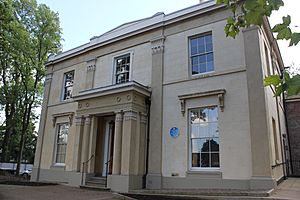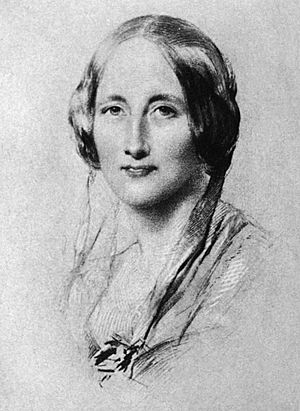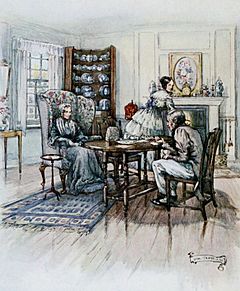Elizabeth Gaskell facts for kids
Quick facts for kids
Elizabeth Gaskell
|
|
|---|---|

Elizabeth Gaskell: 1832 miniature by William John Thomson
|
|
| Born | Elizabeth Cleghorn Stevenson 29 September 1810 Chelsea, London, England |
| Died | 12 November 1865 (aged 55) Holybourne, Hampshire, England |
| Occupation | Novelist |
| Period | 1848–1865 |
| Spouse |
William Gaskell
(m. 1832) |
| Children | 5 |
Elizabeth Cleghorn Gaskell (born Stevenson; 29 September 1810 – 12 November 1865) was an English writer. People often called her Mrs Gaskell. She wrote many novels, biographies, and short stories.
Her books show what life was like for different groups of people in the Victorian era, especially the very poor. Because of this, her work is interesting to people who study history and literature. Her first novel, Mary Barton, came out in 1848.
Elizabeth Gaskell also wrote the first biography of her friend, the famous writer Charlotte Brontë. This book, The Life of Charlotte Brontë, was published in 1857. Some of Gaskell's most famous novels include Cranford (1851–1853), North and South (1854–55), and Wives and Daughters (1865). The BBC has even made TV shows based on all of these books!
Contents
Early Life and Family
Elizabeth Cleghorn Stevenson was born on September 29, 1810, in London. She was the youngest of eight children. Sadly, only she and her older brother, John, survived past infancy.
Her father, William Stevenson, was a Unitarian minister. Unitarians are a Christian group that believes in one God and emphasizes reason and tolerance. Her mother, Elizabeth Holland, came from a family connected to other well-known Unitarian families, like the Wedgwoods and Darwins.
When Elizabeth was just 13 months old, her mother passed away. Her father sent her to live with her aunt, Hannah Lumb, in Knutsford, Cheshire. This town later became famous in her novel Cranford.
In 1814, her father remarried. Elizabeth's brother, John, was meant to join the Royal Navy. Instead, he joined the Merchant Navy and worked for the East India Company. In 1827, John went missing during a trip to India, which was a very sad event for Elizabeth.
Education and Growing Up
Elizabeth spent most of her childhood in Knutsford with her aunt. From 1821 to 1826, she went to a school in Warwickshire. There, she learned about arts, classic literature, and proper manners, which was typical for young ladies from wealthy families at that time.
Her aunts encouraged her to read classic books. Her father also supported her studies and writing. Her brother John would send her new books and tell her about his adventures at sea and in other countries.
After finishing school at age 16, Elizabeth traveled to London to visit her cousins. She also spent time in Newcastle upon Tyne and Edinburgh. In 1832, a miniature portrait of Elizabeth Gaskell was painted by her stepmother's brother, William John Thomson.
Marriage and Starting to Write
On August 30, 1832, Elizabeth married William Gaskell, a Unitarian minister, in Knutsford. After their honeymoon in North Wales, they settled in Manchester. William became the minister at Cross Street Unitarian Chapel.
Manchester was a busy industrial city, and its factories and crowded areas greatly influenced Elizabeth's writing. Her books often explored the lives of people working in these industrial settings.
The Gaskells had five children, but their first daughter was stillborn in 1833. Their other children were Marianne (born 1834), Margaret Emily (called Meta, born 1837), Florence Elizabeth (born 1842), and Julia Bradford (born 1846). Sadly, their son, William, died as a baby in 1845. This tragedy deeply affected Elizabeth and inspired her to write her first novel, Mary Barton.
In 1836, Elizabeth worked with her husband on a collection of poems called Sketches among the Poor. Her first solo work, Clopton Hall, was published in 1840. She also wrote short stories, sometimes using the pen name "Cotton Mather Mills."
Life as a Famous Author
Mary Barton was published in 1848 and became a huge success. It sold thousands of copies and was praised by famous writers like Thomas Carlyle. The book showed readers the difficult lives in the crowded slums of Manchester. People admired Elizabeth's deep feelings and vivid descriptions.
In 1850, the Gaskells moved to a large house at 84 Plymouth Grove in Manchester. Elizabeth continued to write her famous books there. Their home became a meeting place for many important people, including writers, journalists, and social reformers.
Famous visitors included Charles Dickens, John Ruskin, and American writers Harriet Beecher Stowe and Charles Eliot Norton. Her close friend Charlotte Brontë also visited several times.

Elizabeth Gaskell often wrote for Charles Dickens's magazine, Household Words. Many of her works, including Cranford and North and South, first appeared in this magazine.
In 1855, Charlotte Brontë's father asked Gaskell to write his daughter's biography. The Life of Charlotte Brontë was published in 1857. This book helped Elizabeth Gaskell become even more famous.
She continued writing until her death. Her last novel, Wives and Daughters, was being published in parts when she died suddenly of a heart attack in 1865. The book was published in full shortly after her death.
Her grave is located near the Brook Street Chapel, Knutsford.
Literary Style and Themes
Elizabeth Gaskell's writing style is known for being very detailed and realistic. She often used local dialect words in her characters' speech, even for middle-class characters. For example, in North and South, a character suggests "redding up" (tidying) a house.
While her stories followed the rules of Victorian writing, she often used them to criticize the attitudes of her time. Her early works focused on factory life in the Midlands and were influenced by the social ideas of Thomas Carlyle.
Gaskell often highlighted the role of women in her stories. She created complex and realistic female characters. She also explored how different social classes interacted, which is why her books are still studied by historians today.
Important Themes in Her Books
Elizabeth Gaskell was a Unitarian, and her beliefs influenced her writing. Unitarianism teaches understanding and tolerance for all religions. Even though she tried to keep her own beliefs private, these values are clear in her books. For example, in North and South, people from different religious backgrounds "knelt down together. It did them no harm." This shows her belief in people finding common ground.
Legacy and Recognition
The house where Elizabeth Gaskell lived in Manchester, at Plymouth Grove, is now a museum open to the public. It was carefully restored and shows what Victorian life was like.
In 2010, a special memorial to Elizabeth Gaskell was placed in Poets' Corner in Westminster Abbey. This is a very important place where famous writers are honored.
Her novels continue to be popular today. Wives and Daughters was made into a BBC TV series in 1999. In 2004, her novel North and South also became a popular TV miniseries. And in 2007, her novella Cranford was adapted for television, starring famous actress Judi Dench.
The village hall in Silverdale, Lancashire, is called the Gaskell Memorial Hall. It was named after her because a donor offered more money for its construction if it honored Elizabeth Gaskell.
See also
In Spanish: Elizabeth Gaskell para niños



